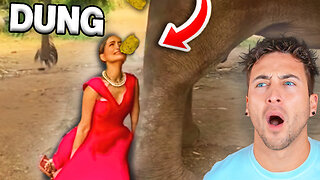Premium Only Content

The Gorilla: Strength, Intelligence, and Family Bonds
The Gorilla: Strength, Intelligence, and Family Bonds
1. Diet and Food
Primary Diet: Gorillas are herbivores. They mainly feed on plant material, including leaves, stems, fruit, and bamboo shoots. Occasionally, they may consume insects, termites, or ants, but plant-based foods make up around 85-90% of their diet.
Feeding Habits: Gorillas spend a large portion of their day foraging for food. They are known to have a strong preference for high-fiber plants. They use their strong hands to strip leaves and bark off trees.
Eating Habits: Gorillas do not travel long distances for food, usually remaining in the same general area if resources are abundant.
2. Reproduction and Mating
Breeding Season: Gorillas can breed year-round, but mating often peaks during the rainy season when food is plentiful.
Gestation Period: The gestation period is approximately 8.5 months (about 257 days).
Cubs: Gorillas typically give birth to one baby at a time. Newborns are helpless and cling to their mothers for the first few months. A baby gorilla is born weighing about 1.8 kg (4 lbs).
Parental Care: The mother is the primary caregiver, and the infant stays with her for several years before becoming independent.
3. Lifespan
In the Wild: Gorillas typically live 35-40 years in the wild.
In Captivity: In protected environments, such as zoos or wildlife sanctuaries, gorillas can live up to 50 years or more.
4. Physical Characteristics
Size:
Height: Adult male gorillas can reach up to 1.8 meters (5.9 feet) tall when standing.
Weight: Adult males (silverbacks) can weigh between 140-200 kg (310-440 lbs), while females weigh between 90-120 kg (200-265 lbs).
Appearance: Gorillas have a broad chest, long arms, and powerful jaws. Their fur is usually dark brown or black, with a silvery sheen on adult males, giving them the "silverback" name. Their faces are expressive, with deep-set eyes and large, strong noses.
5. Habitat
Geography: Gorillas are found in the tropical forests of central Africa, primarily in the rainforests of Cameroon, Gabon, Equatorial Guinea, and the Democratic Republic of the Congo. There are two main species: the eastern gorilla (Gorilla beringei) and the western gorilla (Gorilla gorilla).
Elevation: They live at elevations between 1,200 and 4,200 meters (3,900-13,800 feet) in some areas.
6. Behavior and Adaptations
Social Structure: Gorillas are highly social and live in groups called troops or bands. These groups are led by a dominant male, known as the silverback. The silverback protects the group, makes decisions, and leads foraging efforts.
Communication: Gorillas communicate through a variety of vocalizations, body language, and facial expressions. They can make a range of sounds, including grunts, roars, and hoots.
Tool Use: Gorillas are known to use simple tools, such as sticks to test the depth of water or leaves to create a bed or nest for sleeping.
7. Conservation Status
Gorillas are listed as Endangered by the International Union for Conservation of Nature (IUCN). The population of mountain gorillas (Gorilla beringei beringei) has been slowly increasing due to conservation efforts, but western gorillas remain critically endangered. They face threats from poaching, habitat destruction, and disease.
#Gorilla
#AnimalDocumentary
#GorillaFacts
#Wildlife
#PrimateFamily
#Silverback
#JungleKing
#HumanNature
#EmotionalAnimals
#WildlifeHook
#ViralAnimalVideo
#8KDocumentary
#GorillaStory
-
 LIVE
LIVE
Steven Crowder
2 hours ago🔴 Total Failure: Unpacking The Media's Evil Reaction to the Minneapolis Church Shooting
61,766 watching -
 LIVE
LIVE
Right Side Broadcasting Network
3 hours agoLIVE: White House Press Secretary Karoline Leavitt Holds a Press Briefing - 8/28/25
2,249 watching -
 UPCOMING
UPCOMING
Sean Unpaved
41 minutes agoColt Knost Unplugged: Golf, 2025 Ryder Cup, & Football Fever
-
 LIVE
LIVE
Law&Crime
3 hours ago $0.01 earnedLIVE: Adelson Matriarch Murder Trial — FL v. Donna Adelson — Day 5
1,586 watching -
 LIVE
LIVE
The Mel K Show
16 minutes agoMORNINGS WITH MEL K - Refusing the Lie & Standing Firmly for Truth 8-28-25
102 watching -
 UPCOMING
UPCOMING
The Shannon Joy Show
1 hour ago🔥🔥BREAKING: FOIA’d Government Docs Reveal American Citizens Might Be Worth More DEAD Than Alive. Exclusive With Sasha Latypova! 🔥🔥
1384 -
 LIVE
LIVE
Trumpet Daily
15 minutes agoTrumpet Daily LIVE | Aug. 28, 2025
82 watching -

Nikko Ortiz
1 hour agoLive - Reaction Time, News, Politics, and More!
3.87K -
 1:02:26
1:02:26
VINCE
3 hours agoTragedy In Minneapolis | Episode 113 - 08/28/25
143K140 -
 LIVE
LIVE
Reidboyy
1 hour agoHow To Make $$$ in Delta Force Console Operations!
36 watching